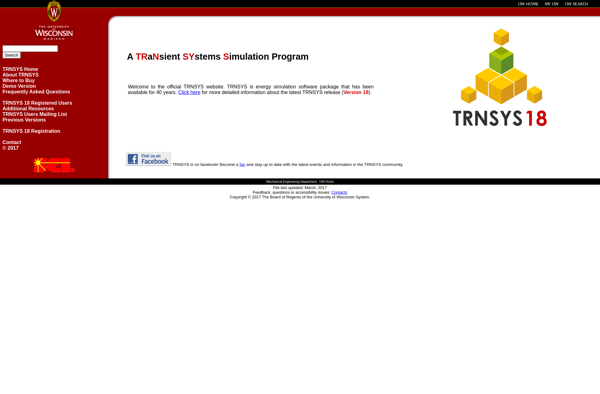TRNSYS

TRNSYS: Transient System Simulation Program
A modular system simulation program for transient systems, with a large component library for energy analysis and design optimization of solar hot water systems.
What is TRNSYS?
TRNSYS (TRaNsient SYstem Simulation program) is a flexible graphically based software environment used to simulate the behavior of transient systems, in particular the performance of thermal and renewable energy systems. It was originally developed at the University of Wisconsin Solar Energy Laboratory in 1975.
TRNSYS features an open modular structure that enables the user to customize and expand the software by adding new mathematical models and component libraries. The software comes bundled with an extensive standard component library for common applications like solar domestic hot water systems, photovoltaic systems, low energy buildings, cogeneration, etc. Users can also create custom components.
At the core of TRNSYS is a transient systems simulation engine that solves complex differential algebraic systems obtained from the components connected in a simulation project. Components are described by mathematical models in the form of ordinary differential, partial differential and algebraic equations. TRNSYS has capabilities for optimization and parametric analysis.
TRNSYS is arguably the most flexible simulation environment for the transient simulation of systems, suitable for renewable energy and building performance modeling. It has a steep learning curve but offers advanced capabilities for detailed analysis and design optimization of complex energy systems over time.
TRNSYS Features
Features
- Modular structure to simulate complex energy systems
- Large component library for modeling HVAC, renewable energy, cogeneration, etc
- Simulation Studio graphical interface for building models
- TRNBuild for automatically generating building input files
- TRNSYS3d for integrating 3D building models
- Detailed system component models
- Flexible system configuration
- Transient performance simulations
- Parametric analyses
Pricing
- One-time Purchase
- Subscription-Based
Pros
Cons
Official Links
Reviews & Ratings
Login to ReviewThe Best TRNSYS Alternatives
Top Science & Engineering and Simulation Software and other similar apps like TRNSYS
Here are some alternatives to TRNSYS:
Suggest an alternative ❐Aspen Plus

Engineering Equation Solver

GateCycle Software

EBSILONProfessional
